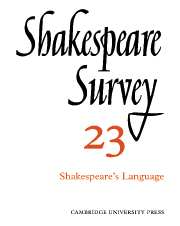Book contents
- Frontmatter
- Shakespeare and the Tune of the Time
- Some Functions of Shakespearian Word-formation
- Guide-lines for Interpreting the Uses of the Suffix ‘-ed’ in Shakespeare’s English
- Shakespeare’s Use of Colloquial Language
- Words, Action, and Artistic Economy
- ‘Antony and Cleopatra’: the Limits of Mythology
- Shakespeare’s ‘War with Time’: the Sonnets and ‘Richard II’
- Shakespeare and Christian Doctrine: Some Qualifications
- Shakespeare’s Poets
- The Text of Coleridge’s 1811–12 Shakespeare Lectures
- Shakespeare Studies in German: 1959–68
- A Neglected Jones/Webb Theatre Project: ‘Barber-Surgeons’ Hall Writ Large
- Interpretation or Experience? Shakespeare at Stratford
- 1 Critical Studies
- 2 Shakespeare’s Life, Times, and Stage
- 3 Textual Studies
- Index
- Plate section
‘Antony and Cleopatra’: the Limits of Mythology
Published online by Cambridge University Press: 28 March 2007
- Frontmatter
- Shakespeare and the Tune of the Time
- Some Functions of Shakespearian Word-formation
- Guide-lines for Interpreting the Uses of the Suffix ‘-ed’ in Shakespeare’s English
- Shakespeare’s Use of Colloquial Language
- Words, Action, and Artistic Economy
- ‘Antony and Cleopatra’: the Limits of Mythology
- Shakespeare’s ‘War with Time’: the Sonnets and ‘Richard II’
- Shakespeare and Christian Doctrine: Some Qualifications
- Shakespeare’s Poets
- The Text of Coleridge’s 1811–12 Shakespeare Lectures
- Shakespeare Studies in German: 1959–68
- A Neglected Jones/Webb Theatre Project: ‘Barber-Surgeons’ Hall Writ Large
- Interpretation or Experience? Shakespeare at Stratford
- 1 Critical Studies
- 2 Shakespeare’s Life, Times, and Stage
- 3 Textual Studies
- Index
- Plate section
Summary
When critics speak of myth and ritual in Shakespeare they have in mind chiefly the symbolic structure of the plays. Thus The Winter’s Tale which begins in winter (‘a sad tale’s best for winter’, i, i, 25) and ends in high summer (‘not yet on summer’s death nor on the birth of trembling winter’, iv, iv, 80) perfectly corresponds to the fertility rhythm. The accent on fertility in the sheep-shearing in Act IV gives to the structural form its emotional and spiritual content, whilst the symbolic revival of Hermione at the end rounds off the pattern of death and resurrection so basic to ‘the myth of the eternal return’. Such an archetypal structure is older than Christianity (in spite of the Christian colouring) and perhaps older than the conscious memory of man.
In King Lear the symbolic structure of the play viewed as myth-ritual is defined by the image of the wheel. Lear speaks of himself as being bound on a wheel of fire (iv, vii, 47); Kent bids Fortune turn her wheel (ii, ii, 173); the Fool speaking of the fate of his master bids himself 'let go thy hold when a great wheel runs down a hill' (ii, iv, 71); whilst Edmund acknowledges at his death that 'the wheel is come full circle' (v, iii, 174). The circular movement thus intimated has behind it a sense of a cyclical order, the rise and fall of kings ordained as a means of guaranteeing the fertility of the land and the orderly sequence of the seasons. Such imagery, more than it is a statement about Lear as a Nature-god (though he is that too), is a statement about his predetermined fate, and about the structure of the play in which that fate is projected.
- Type
- Chapter
- Information
- Shakespeare Survey , pp. 59 - 68Publisher: Cambridge University PressPrint publication year: 1970
- 2
- Cited by

